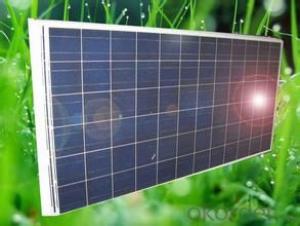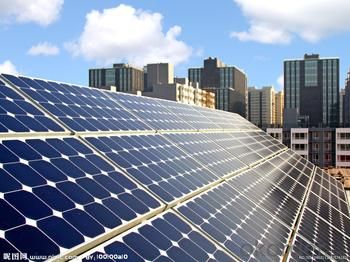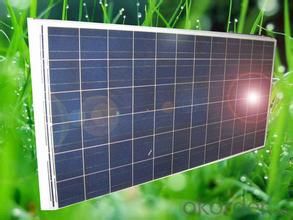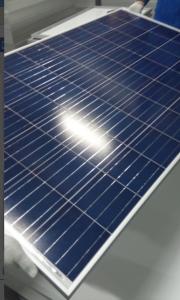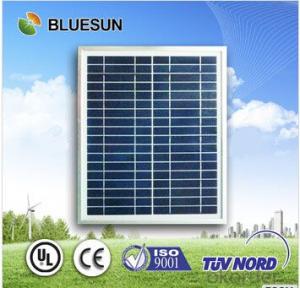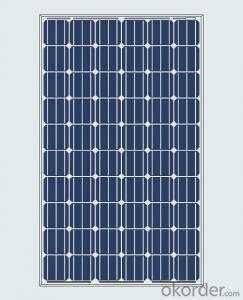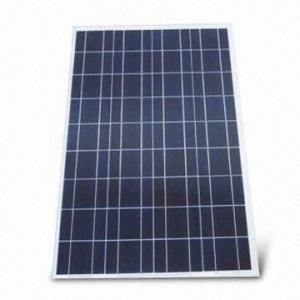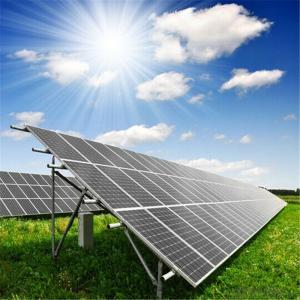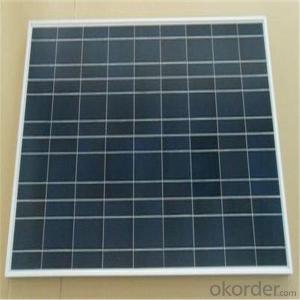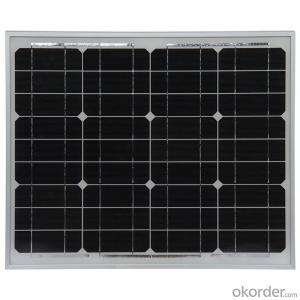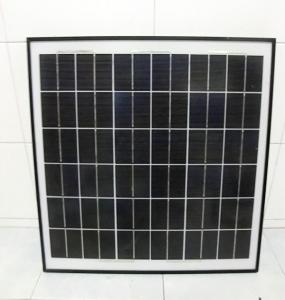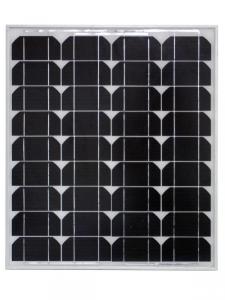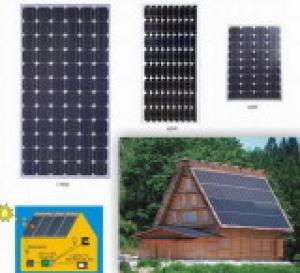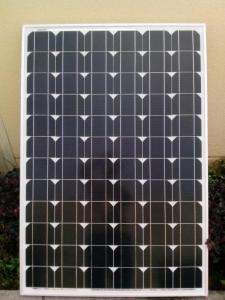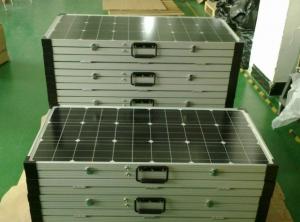Solartech 300w All Black Poly Crystalline Silicon PV Solar Module
- Loading Port:
- China main port
- Payment Terms:
- TT OR LC
- Min Order Qty:
- 1 pc
- Supply Capability:
- 100000000 pc/month
OKorder Service Pledge
OKorder Financial Service
You Might Also Like
Quick Details
| Place of Origin: | Guangdong China (Mainland) | Brand Name: | HUAYU | Model Number: | HYS-120WM36V |
| Material: | Monocrystalline Silicon | Size: | 1196*669*35mm | Number of Cells: | 72 |
| Max. Power: | 120W | Certification: | ISO/CE/TUV/UL | Application: | Home |
| Warranty: | 20 years limited warranty on power | Solar Cell: | A-grade,high efficiency | Frame: | Aluminium Alloy |
| Glass: | Toughened Glass | EVA: | Highly Adhesive | Backsheet: | TPT/TPE(Block Humidity and Oxy Effectively ) |
| Specification: | Normal |
Packaging & Delivery
| Packaging Detail: | wood case and pallet |
| Delivery Detail: | 10 days |
Specifications
solar module 100wp
High Quality Monocrystalline solar Panel 120W/36V,also provide solar power system
The Best New photovoltaic solar Panels mono , solar system,120W/36V, solar photovoltaic ,solar system,iso certified companies
Principle of solar system

A grade high efficiency solar cells.
15 years limited warranty on material and workmanship
20 years limited warranty onpower
Characteristics
Modules: HYS120WM-36V
Cell: Monocrystalline solar cells (156*61mm)
NO. of cell: 72(4*18)
Maximum power at STC(Pm): 120W
Open circuit voltage(Voc): 42.48V
Optimum operating voltage(Vmp): 35.2V
Short circuit current(Isc): 3.77A
Optimum operating current(Imp): 3.40A
Dimension of module: 1196*669*35mm
Weight: 10kg
Certificate: ISO/CE/TUV/UL
STC:Irradiance 1000W/m2 ,Module temperature 25°C,AM=1.5 Blueprint of the module
Limits
Operating temperature: (-40 to +85°C)
Maximum System voltage: 1000VDC
Temperature and Coefficients
NOCT: (48±2)°C
Current temperature coefficients: (0.06±0.01)%/K
Voltage temperature coefficients: (-155±10)mV/K
Voltage temperature coefficients: (-0.5±0.05)%/K
NOCT:Nominal operation Temperature
Performance Warranty
15 years limited warranty on material and workmanship
20 years limited warranty on power output
Output
Type of terminal: Junction box
Cable: LAPP(4.0mm2)
Asymmetrical lengths: 900mm
The publication summarises warranty and specifications which are subject to change without notice.
- Q: Can solar panels be installed on assisted living facilities?
- Yes, solar panels can be installed on assisted living facilities. In fact, many assisted living facilities are now opting for solar panel installations to reduce their energy costs and carbon footprint. Installing solar panels on these facilities not only helps save money in the long run but also promotes sustainability and environmental responsibility.
- Q: Solar panels do good more then bad?
- It is like running a single large power plant instead of all of us having our home small fossil fuel electricity generators. You can have better and effective environment at a single source at large scale then at smaller sources. Most would just not care much. On separate line if the solar panels were to become more common in use, industries will be efficient and environment friendly ways to make them. Thus increasing their effectiveness as good green cause.
- Q: Which of these units determines how much electric energy a solar panel can generate?
- Have okorder . It might surely benefit anyone!
- Q: I'm going to pitch an idead to my school about switching to Solar Energy. What are positive and negative effects of the solar panels?Also what is the cost for installing them into a highschool?How much would the electricity bill decline afterwards?
- If you hope to get a solar panel that can run appliances and air conditioning.. then you are not even close to being realistic about what solar panels can do. If you really want to install a solar panel array on your home, then you need to talk to a company in your area that designes and installes them because every installation is different.. so you won't get an answer here on Yahoo. You can expect to spend $20,000 to $30,000 that will provide enough solar power for the average home.
- Q: So I want to power one of my car fans with some solar panels. I ordered quite a few and I want to power one of my fans under the hood. I've already disconnected the fan and pulled it out of the car to test it later.What all do I need besides the panels, fan, and wiring to make this work. This fan will not be tied to any other system. Currently, the fan is not operated by the car or any system of the car due to a modification made to the automobile allowing me to disconnect it from use months ago.Using the fan powered from the solar panels would help with the modification to increase air flow and speed into the area.Could someone please help me by telling me what else I need to make the fan operational from here?
- The solar panel doesn't output enough power to run the fan directly, your best bet would be to just hook the fan back up to the battery, and then rig the solar panels up to help charge the battery and remove some of the load from the alternator. If you're trying to reduce your emissions/increase fuel economy then you'd be better of setting up a switch to disconnect your alternator when its not necessary to have it on. The alternator runs off a belt from the engine which requires some of the power output from the engine. Having this connected all the time increases the amount of gas used (marginally) but you'd be saving more gas doing that and using the solar panels to keep the battery topped up.
- Q: Any opinion on harbor freight solar panels ?
- Yes -- don't buy them. They are low quality solar panels, and the e-z kit they sell produces barely enough power for a lightbulb. The kit they commonly sell is a good child's science fair experiment/project, but do not expect to get your money's worth in solar power. If you are attempting to self-teach yourself on solar panels, this might be a good starting point, if not also a little expensive. But again, do not purchase Harbor Freight solar panels, or their e-z kit. If you are serious about getting into solar panels, there are distributors who will gladly talk to you about what kind of solar panels you will need for a regular house (hint: it is actually a pretty big set of solar panels for even a low power usage home).
- Q: I have to show in a project (a model house) how Solar Panels work. In my model I want to show Solar Panels creating electricity to power a T.V but I need to show how the power gets from the Solar Panels to the T.V. A diagram would be really helpful. Please try and make this as simple as possible as I'm only 3, but try and be specific as well!
- Light consists of small packets of energy called photons. When photons with sufficient energy strike the photocell its energy is converted into electrical energy which is stored in the batteries as dc voltage. To run a TV an invertor is used which converts dc to ac. Now you can make a block diagram of it and present it TC
- Q: what is the average cost, for a single family home, to install solar panels? I live in CA.
- Depends on the size of your home, how many appliances you want to run at one time, and how much sunlight you get because all of that determines how many panels you need and how many batteries you need to install. I checked into it earlier this year and it was going to take almost 25 years to pay for itself. They aren't cheap.
- Q: Could you have a solar panel in space that would transmit electricity remotely? Maybe have some kind of receiving antenna to pick up the energy? Perhaps there could be a string of them orbiting the Earth?Why wouldn't that work?
- Absolutely. Many satellites and other spacecraft that have been launched throughout history carry solar panels to power themselves. The International Space Station alone has hundreds of square meters of solar panels. Transmitting the power from one place to another wirelessly is a bit more difficult, but not fundamentally impossible. So far we don't have any good technology to do it over long distances. But we're getting there. One proposed future source of power is 'solar power satellites', orbiting devices that would collect sunlight and turn it into a microwave laser that would be fired down to the Earth and collected in a giant dish kind of like a radio telescope. The idea is that this would be non-polluting, environmentally friendly, reliable, would help to boost investment in space technologies, and wouldn't take up the large amounts of land area required for traditional solar power. However, some people have argued that it is a bad idea on the basis that if the laser accidentally missed the dish, and came down in an inhabited area, it might cause human fatalities or damage to the environment or human artifacts.
- Q: How much roof space is needed for solar panels?
- The amount of roof space needed for solar panels varies depending on several factors such as the size and type of panels, the energy requirements of the property, and the efficiency of the panels. However, as a general rule of thumb, a typical 1 kW solar panel system requires around 100 square feet of roof space.
Send your message to us
Solartech 300w All Black Poly Crystalline Silicon PV Solar Module
- Loading Port:
- China main port
- Payment Terms:
- TT OR LC
- Min Order Qty:
- 1 pc
- Supply Capability:
- 100000000 pc/month
OKorder Service Pledge
OKorder Financial Service
Similar products
Hot products
Hot Searches
Related keywords

